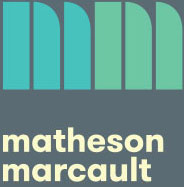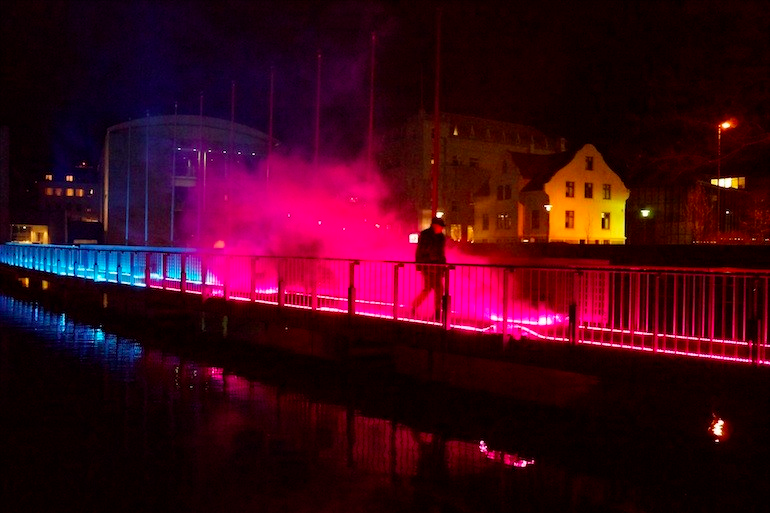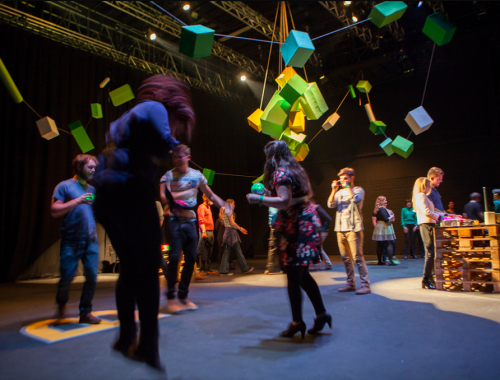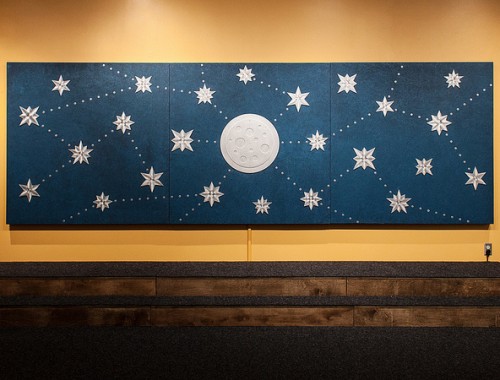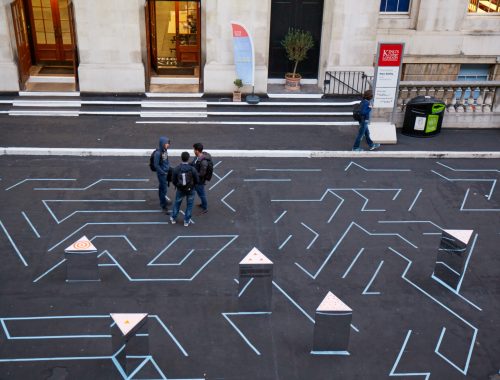As part of our research project for the King’s College London Arts and Humanities Festival, we’ve been interviewing different curators, designers, artists and architects about playful work for public space. This interview is with Tine Bech, a multidisciplinary artist and researcher. Her work explores the potential for transforming environments and human behaviour through the creative possibilities of play and game-making.
Her PhD thesis Playful interactions: A Critical Inquiry into Interactive Art and Play is available online, and gives a really interesting overview of some of her work and the things she’s discovered making it. The image above shows her work On The Bridge.
US: I wanted to ask about the invitations your work extends to people, these different invitations to play. You talk a lot in your thesis about how tiny little details make a big difference to how people respond – like with Catch Me Now, you talk about the difference made by how long a spotlight pauses for and how big it is, what colour it is. [Catch Me Now is a gently roaming spotlight that responds when you step into it, expanding to invite you to perform, but then quickly runs away from you]
I was wondering – is there anything more you can tell me about that? Silly example, I guess, but are there colours that are just more playful, for example?
TINE: I think for me the question of little details is more about being aware of how the body responds to different situations. I often draw on play theorists like Caillois and on aspects of letting go and having the body in movement, and how movement is the gateway into play. So I’m interested in an interactivity which is physical, visually physical gestures.
The body seems to count time differently than we do rigidly in our heads. So for something like Catch Me Now it’s very much a matter of hands-on testing, watching people, trying things out. I think the answer really is in how the body feels. It’s actually a quite fine-tuned element of interactive playing or interactive engagement that has to be quite precise.
It looks undisciplined because you’re creating something that other people are interacting with – and people are wonderfully unpredictable. I’ve just written something online about this, the idea that “one subtle change, one step, leads to bigger change”. So one subtle invitation is to step in, and then there’s this sort of flow of commitment that leads to bigger things. Bigger moments.
US: You also talk a bit about how known affordances and familiar things help people to understand what they’re meant to do, and what they can do, and that there even is an invitation. Things about how a spotlight tells you a little bit about what it’s for.
I was really interested by a thing you said in an almost throwaway sentence, which is that the growth of motion sensing and proximity sensing in doors and taps and so on is expanding the range of interactions that people understand instinctively, and the range of affordances they can comprehend … does that still feel like that’s something that’s growing, the range of things people understand?
TINE: I think it’s an ever-changing landscape. Even people who stick to very known familiar readings (cultural interpretations of our world) of what is around them also are affected and changed. So, say, my mum knows how to zoom in and zoom out, that twist, that finger movement that we all use on phones now. That sort of gesture (physical) language – when you watch someone in the bathroom and they’re turning on the taps, they try the waving or turning motion. It leads back to the classic affordance of” a knob wants to be turned, a handle wants to be pushed” that Norman talks about in Emotional Design I think. There is an ever-growing changing interactive landscape that is around us, and technology is part of that.
I watch my own behaviour change, and if I look back not very many years I can compare what I would normally do then to what I normally do now in communal public common spaces. It’s a very interesting field actually.
US: I was reminded, reading that line, of a thing I saw a couple of weeks back in an airport bathroom which was a – maybe a fourteen or fifteen year old girl who spent a minute trying to get the tap to work. She was getting quite frustrated because she didn’t realise that you just had to turn the taps. I guess she hadn’t encountered that sort of taps in public before so that understanding has become a dormant thing…
You also talk a bit about the idea of costume as a way of getting people to step into play, and the idea that the capes that people wear in Tracking You [in which participants wear capes that track their location, and different sounds are played depending on where people are and what they’re doing] is a reference to Parangolés.
TINE: Yes, Oiticica used capes in his work originally in the 60s, you can trace him back to be a very interesting part of the process of breaking down the boundaries between the audience and the artwork. I think for me it relates again to play theory, the dressing up aspect. Taking on another persona allows you to be in play.
US: Do you find that people need to have a clearer sense of what they’re in for before they’ll put a cape on? It’s quite a big thing to do, quite a big threshold to step over as opposed to walking into a spotlight or walking over a bridge. Is it harder to get people to do that?
TINE: It’s all to do with the barrier to participation and whether you can make it low enough through a readable invitation. It’s that triangle of “readable, reliable, robust” (what I call the three RRR): readable in this case meaning we sort-of get a sense by a cape of what to do and what it’s linked to. The three RRR is not ‘boring without magic’ as some think, because at the same time it’s linked to the idea of flow: if it’s too easy we get bored, and if it has an element of difficulty we’ll be intrigued, it leads us to continuing to play, doing it again and again because it’s enjoyable or because it is empowering us to figure things out. The joy of absorbing and moving, the “yay” moment.
Compared to some interactive artists I’m very particular about this. I want people to have a sense of what’s going to happen. I think if you make it too hard or oblique, which a lot of technologists or artists do like and which can have merit – I believe that for play you have to allow people to become masters of play. It shouldn’t be boring! But it’s very important that people understand it.
That doesn’t mean it should be shallow or not important or obvious. You can still have mystique, you can still have experimentation being rewarded, the unexpected.
US: Your experience with adults and children has been very very similar to ours, which is that once you have a few children playing it’s very difficult to convince adults that it’s okay for them to continue to play. They see children playing and then they step back.
You also talk about how people play when they see other people playing, and how you can sometimes send an adult into a group of children to indicate that it’s all right for them to play. Are there any other techniques you’ve come across that have helped you deal with adults stepping back from play?
TINE: Yeah, it’s a really really hard one. We have a hierarchy of play where children are at the top; perhaps rightly so, and perhaps not. And that is our culture. It’s linked to bigger cultural assumptions. It’s interesting to be aware of it and as you mention you sometimes need to have a demonstration of adult play, because imitation and watching people and taking turns is very much part of our social behaviour. So being aware of this and using it, it’s a method. And also being aware that different spaces you work in is linked to a diversity of different cultural behaviours.
I think also if you put the invitation out in a particular way you can help to deliberately imply that something is for everybody, but yes it’s a very hard assumption that play is only for children to counteract.
If you look at science, science isn’t so scared of demonstrating and facilitating, while art is. If you look at science demonstrations you’ll often have someone standing there facilitating. If you go to conferences or exhibitions where you have an art-technology outlook and a science one, you have different approaches to how things are presented. Again it’s the old fine art thinking – you put something there and leave it and it’s up to the audience. You then have some artists saying “I don’t mind talking about it” and others saying “I won’t talk about it, my job is done”. But scientists come with a different approach – wanting to facilitate their work, talk about it. So I think we could learn from other fields as well.
